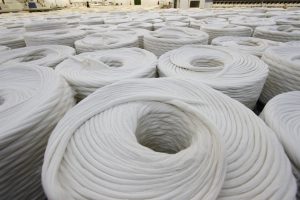Biodegradable Cotton: Nature’s Sustainable Solution – Part One
Brazilian cotton |
The landscape of fashion trends and consumer consciousness continues to evolve as the focus is shifting from mere aesthetics to deeper conversations surrounding sustainability and environmental impact. As Denim Dudes aptly put it, “As the world’s changing, consumers need to be educated about clothing.”
One crucial aspect of this education is understanding the biodegradability of materials, particularly cotton, and its significance in shaping a more sustainable future.
In this article, we will explore the biodegradability of cotton and compare it to other fabrications.
What is Biodegradability and Why is it Important
The topic of the biodegradability of materials is essential in the discussion of environmental sustainability. When something can be naturally broken down into smaller and smaller pieces over time, by tiny living things (microorganisms) it is considered biodegradable.
Cotton’s Inherent Biodegradability
Cotton is a natural fiber derived from plants. Cotton farmers grow the crop and then harvest it. After harvesting, a process called ginning occurs, where the cotton is dried and separated from any seeds or debris. The fiber is then compressed into traceable bales and sent to a mill to be spun, woven or knitted, pressed, dyed, chemically treated, cut, sewn, and distributed to the consumer in various products.
 Natural vs. Synthetic Cotton
Natural vs. Synthetic Cotton
When discussing cotton’s biodegradability, we need to consider whether it’s natural or synthetic.
Natural cotton is a raw material made of cellulose, an organic compound that can biodegrade quickly, returning resources to the earth.
While synthetic cotton, also referred to as “cotton blends,” is an innovative effort to embody some of cotton’s natural characteristics, mixing cotton with synthetic fibers is incredibly harmful to the environment. Not only does it create microplastics, but it also hinders the biodegradability of the cotton within the blend.
Comparing Biodegradable Fabrics: Cotton with Synthetic Fibers
Whether natural or synthetic, most materials have an incredibly long biodegradability timeline. Cotton’s plastic-based competitors “like acrylic, nylon, fleece, polyester, and rayon are some of the least biodegradable fabrics on the market,” according to a study Green Matters reviewed. As seen in the table above, and in this article, cotton can take between one week and five months to biodegrade, depending on the nature of the cotton and treatments utilized, while polyester can take up to 200 years.
As seen in the table above, and in this article, cotton can take between one week and five months to biodegrade, depending on the nature of the cotton and treatments utilized, while polyester can take up to 200 years.
Polyester is essentially plastic! It’s made of the same main ingredient as plastic water bottles, PET, and as noted by CottonInc, it “breaks down in soil or water at similar rates as other materials made of this plastic.”

Not only does polyester take an extensive amount of time to break down, it also biodegrades into tiny fibers called microplastics.
“While cotton also releases fibers in the wash, these small fibers biodegrade much quicker and more thoroughly than microplastics produced by synthetic materials. Cotton, like all plants, is grown from the earth and can return to the earth safely and quickly under a variety of conditions.” (CottonInc)
Embracing natural materials like cotton and supporting eco-conscious practices are essential steps toward understanding and enhancing the environmental impact of fashion and consumption.
Stay tuned for Part Two!! There, we will examine the impact of finishes on cotton’s ability to biodegrade, discuss its compostability, and address the overall environmental effects of biodegradation.






